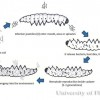Abstract
Entomopathogenic nematodes are soft bodied, non-segmented roundworms that are obligate or sometimes facultative parasites of insects. They occur naturally in soil environments and locate their host in response to carbon dioxide, vibration, and other chemical cues. They fit nicely into integrated pest management programs because they are nontoxic to humans, specific to their target pests, and can be applied with standard pesticide equipment. This 4-page fact sheet was written by Nastaran Tofangsazie, Steven P. Arthurs, and Robin M. Giblin-Davis, and published by the UF Department of Entomology and Nematology, August 2012.
References
Bedding R, Molyneux A. 1982. Penetration of insect cuticle by infective juveniles of Heterorhabditis spp. (Heterorhabditidae: Nematoda). Nematologica 28: 354-359. https://doi.org/10.1163/187529282X00402
Grewal P, Lewis E, Gaugler R, Campbell J. 1994a. Host finding behaviour as a predictor of foraging strategy in entomopathogenic nematodes. Parasitology 108: 207-215. https://doi.org/10.1017/S003118200006830X
Grewal PS, Selvan S, Gaugler R. 1994b. Thermal adaptation of entomopathogenic nematodes-niche breadth for infection, establishment and reproduction. Journal of Thermal Biology 19: 245-253. https://doi.org/10.1016/0306-4565(94)90047-7
Grewal PS, Ehlers R-U, Shapiro-Ilan DI. 2005. Nematodes as Biocontrol Agents. CABI, New York, NY. https://doi.org/10.1079/9780851990170.0000
Kaya HK, Gaugler R. 1993. Entomopathogenic nematodes. Annual Review of Entomology 38: 181-206. https://doi.org/10.1146/annurev.en.38.010193.001145
Shapiro-Ilan DI, Gaugler R. 2002. Production technology for entomopathogenic nematodes and their bacterial symbionts. Journal of Industrial Microbiology and Biotechnology 28: 137-146. https://doi.org/10.1038/sj.jim.7000230
Shapiro-Ilan DI, Gouge DH, Koppenhofer AM. 2002. Factors affecting commercial success: case studies in cotton, turf and citrus. In: Gaugler R. (Ed.), Entomopathogenic Nematology. CABI, New York, NY, pp. 333-356. https://doi.org/10.1079/9780851995670.0333
Shapiro-Ilan DI, Gough DH, Piggott SJ, Patterson Fife J. 2006. Application technology and environmental considerations for use of entomopathogenic nematodes in biological control. Biological Control 38: 124-133. https://doi.org/10.1016/j.biocontrol.2005.09.005
Shapiro-Ilan DI, Cottrell TE, Mizell RF, Horton DL, Behle B, Dunlap C. 2010. Efficacy of Steinernema carpocapsae for control of the lesser peachtree borer, Synanthedon pictipes: Improved aboveground suppression with a novel gel application. Biological Control 54: 23-28. https://doi.org/10.1016/j.biocontrol.2009.11.009
White GF. 1927. A method for obtaining infective nematode larvae from cultures. Science 66: 302-303. https://doi.org/10.1126/science.66.1709.302.b

